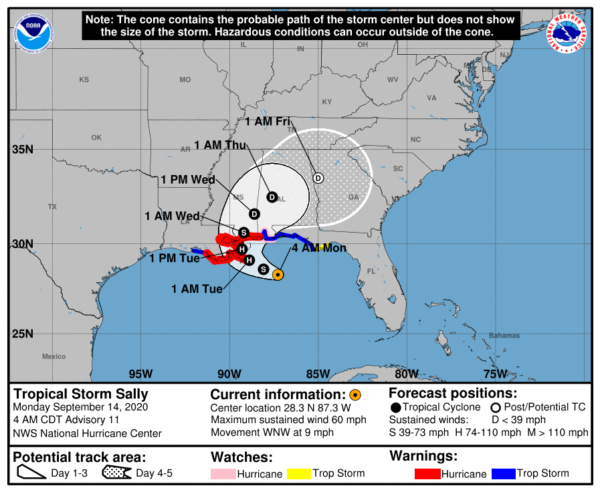Sally’s Outer Bands Approaching the Northern Gulf Coast
SUMMARY OF 400 AM CDT…0900 UTC…INFORMATION
———————————————-
LOCATION…28.3N 87.3W
ABOUT 120 MI…195 KM ESE OF THE MOUTH OF THE MISSISSIPPI RIVER
ABOUT 175 MI…280 KM SE OF BILOXI MISSISSIPPI
MAXIMUM SUSTAINED WINDS…60 MPH…95 KM/H
PRESENT MOVEMENT…WNW OR 285 DEGREES AT 9 MPH…15 KM/H
MINIMUM CENTRAL PRESSURE…996 MB…29.42 INCHES
WATCHES AND WARNINGS
——————–
CHANGES WITH THIS ADVISORY:
None.
SUMMARY OF WATCHES AND WARNINGS IN EFFECT:
A Storm Surge Warning is in effect for…
* Port Fourchon Louisiana to the Alabama/Florida Border
* Lake Pontchartrain, Lake Maurepas, and Lake Borgne
* Mobile Bay
A Hurricane Warning is in effect for…
* Morgan City Louisiana to the Mississippi/Alabama Border
* Lake Pontchartrain and Lake Maurepas including metropolitan New
Orleans
A Tropical Storm Warning is in effect for…
* Mississippi/Alabama Border to Indian Pass Florida
* Intracoastal City Louisiana to west of Morgan City
A Hurricane Watch is in effect for…
* Mississippi/Alabama Border to the Alabama/Florida Border
A Tropical Storm Watch is in effect for…
* Indian Pass to Ochlockonee River Florida
DISCUSSION AND OUTLOOK
———————-
At 400 AM CDT (0900 UTC), the center of Tropical Storm Sally was
located near latitude 28.3 North, longitude 87.3 West. Sally is
moving toward the west-northwest near 9 mph (15 km/h). This
general motion is expected today, followed by a decrease in
forward speed and a turn to the northwest tonight and a northward
turn sometime on Tuesday. On the forecast track, the center of
Sally will move over the north-central Gulf of Mexico today, and
approach southeastern Louisiana this afternoon, and make landfall
in the hurricane warning area on Tuesday. Afterward, Sally is
expected to move slowly north-northeastward near the northern Gulf
Coast through Wednesday.
Maximum sustained winds are near 60 mph (95 km/h) with higher gusts.
Strengthening is expected over the next day or so, and Sally
is forecast to become a hurricane by tonight, with additional
strengthening possible before the center crosses the northern Gulf
Coast.
Tropical-storm-force winds extend outward up to 125 miles (205 km)
from the center.
The estimated minimum central pressure based on dropsonde data from
the NOAA Hurricane Hunters is 996 mb (29.42 inches).
HAZARDS AFFECTING LAND
———————-
Key messages for Sally can be found in the Tropical Cyclone
Discussion under AWIPS header MIATCDAT4 and WMO header WTNT44 KNHC,
and on the web at www.hurricanes.gov/text/MIATCDAT4.shtml
STORM SURGE: The combination of a dangerous storm surge and the
tide will cause normally dry areas near the coast to be flooded by
rising waters moving inland from the shoreline. The water could
reach the following heights above ground somewhere in the indicated
areas if the peak surge occurs at the time of high tide…
• Mouth of the Mississippi River to Ocean Springs including Lake
Borgne…7-11 ft
• Ocean Springs to MS/AL Border…5-8 ft
• MS/AL Border to AL/FL Border including Mobile Bay…4-6 ft
• Lake Pontchartrain and Lake Maurepas…4-6 ft
• Port Fourchon to Mouth of the Mississippi River…3-5 ft
• AL/FL Border to Navarre including Pensacola Bay…2-4 ft
• Navarre to Chassahowitzka including Choctawhatchee Bay and Saint
Andrew Bay…1-3 ft
• Burns Point to Port Fourchon…1-3 ft
Overtopping of local levees outside of the Hurricane and Storm
Damage Risk Reduction System is possible where local inundation
values may be higher than those shown above.
The deepest water will occur along the immediate coast in areas of
onshore winds, where the surge will be accompanied by large and
damaging waves. Surge-related flooding depends on the relative
timing of the surge and the tidal cycle, and can vary greatly over
short distances. For information specific to your area, please see
products issued by your local National Weather Service forecast
office.
WIND: Hurricane conditions are expected within the hurricane
warning area starting late today. Tropical storm conditions are
possible within the watch area during the next few hours, and are
expected within the warning area beginning this morning.
RAINFALL: Sally is expected to be a slow-moving system as it
approaches land producing 8 to 16 inches of rainfall with isolated
amounts of 24 inches over portions of the central Gulf Coast from
the western Florida Panhandle to far southeast Louisiana through the
middle of the week. Life-threatening flash flooding is possible. In
addition, this rainfall will likely lead to widespread minor to
isolated major flooding on area rivers.
Sally is forecast to turn inland early Wednesday and track into the
Southeast with rainfall of 6 to 12 inches possible across portions
of inland southeast Mississippi and Alabama. Significant flash and
urban flooding is likely, as well as widespread minor to moderate
flooding on some rivers.
Further heavy rain is then anticipated across portions of eastern
Tennessee, northern Georgia and western North Carolina Thursday into
Friday. Flash, urban, and minor river flooding is possible across
this region.
Outer bands of Sally are expected to produce additional rainfall of
1 to 3 inches across the Florida peninsula today. This rainfall may
produce flash and urban flooding and prolong high flows and ongoing
minor flooding on rivers across central Florida.
TORNADOES: A tornado or two may occur this afternoon through
Tuesday over coastal areas of the Florida Panhandle, Mississippi,
Alabama, and extreme southeastern Louisiana.
SURF: Swells from Sally are affecting the west coast of the
Florida peninsula westward through the coast of Alabama, and will
be spreading northwestward along the northern Gulf coast through
today. These swells are likely to cause life-threatening surf
and rip current conditions. Please consult products from your
local weather office.
Category: Alabama's Weather, ALL POSTS, Severe Weather, Tropical
















